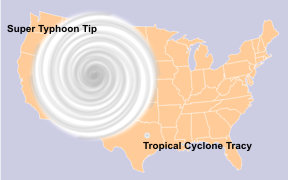Once in a while however...
These Pacific monsters make a lie of the ocean's name.
First off, they can get very big:


That's 1979's super-typhoon Tip, a bit less than half the size of the contiguous United States.
Secondly they can develop very high wind speeds. In 1996 Severe Tropical Cyclone Olivia had a wind gust measured at 253mph, the world record non-tornadic wind speed. See below for some of the other measures.*
Third, the combination of size and strength can be very destructive.
There are stories of fleets destroyed by these storms that go back centuries. Kublai Khan's attempted invasions of Japan in 1274 and 1281 were probably thwarted by "kamikaze" (divine wind).
In December 1944 U.S. Admiral Halsey tried to beat past Typhoon Cobra and suffered some large losses:
"...three destroyers, the Spence, Hickox, and Maddox, capsized and sank in the high seas. Nine other ships were substantially damaged and over 100 aircraft were lost. 790 men were killed in the typhoon, but 93 sailors were rescued from the sea...." More after the jump.**From Sputnik:
Super Typhoon Lan to Make Direct Hit on Tokyo
From Stars and Stripes:Speeding north at almost 20 mph, Super Typhoon Lan, packing 150-mph sustained winds and 184-mph gusts, is scheduled to strike Japan’s largest metropolis at about 6 a.m. local time on Monday.
Officials have been placed on high alert as schools and some travel corridors are expected to be closed on Monday as the dangerous Category 4 storm is expected to bring heavy rains, wind-related damage and a destructive tidal surge to the region.
Currently some 300 miles east of Japan, super-typhoon Lan forecasts warn of landslides and flash flooding inland around the Tokyo metropolitan area, home to some 38 million people, or about 30 percent of the nation‘s population....MORE

Arrival at the start of the work day may be fortunate, if people stay home.
We'll be back with more tomorrow.
*From Wunderground via our October 23, 2016 post on Mexico's Hurricane Patricia (200 mph winds):
...Patricia's 200 mph sustained winds make it the 3rd strongest tropical cyclone in world history (by 1-minute averaged wind speed.) Officially, here are the strongest tropical cyclones in world history, according to the Joint Typhoon Warning Center and the National Hurricane Center (using 1-minute averaged sustained winds):
Super Typhoon Nancy (1961), 215 mph winds, 882 mb. Made landfall as a Cat 2 in Japan, killing 191 people.
Super Typhoon Violet (1961), 205 mph winds, 886 mb pressure. Made landfall in Japan as a tropical storm, killing 2 people.
Super Typhoon Ida (1958), 200 mph winds, 877 mb pressure. Made landfall as a Cat 1 in Japan, killing 1269 people
.Super Typhoon Haiyan (2013), 195 mph winds, 895 mb pressure. Made landfall in the Philippines at peak strength.
Super Typhoon Kit (1966), 195 mph winds, 880 mb. Did not make landfall.
Super Typhoon Sally (1964), 195 mph winds, 895 mb. Made landfall as a Cat 4 in the Philippines.
However, it is now recognized (Black 1992) that the maximum sustained winds estimated for typhoons during the 1940s to 1960s were too strong. The strongest reliably measured tropical cyclones were both 10 mph weaker than Patricia, with 190 mph winds—the Western Pacific's Super Typhoon Tip of 1979, and the Atlantic's Hurricane Allen of 1980. Both storms had a hurricane hunter aircraft inside of them to measure their top winds. Haiyan's winds were estimated using only satellite images, making its intensity estimate of lower confidence. ...MUCH MORE** Via Wikipedia's Typhoon Cobra page:
...3rd Fleet damage
- USS Hull - with 70% fuel aboard, capsized and sunk with 202 men drowned (62 survivors)[3]
- USS Monaghan - capsized and sunk with 256 men drowned (six survivors)[3]
- USS Spence - rudder jammed hard to starboard, capsized and sunk with 317 men drowned (23 survivors) after hoses parted attempting to refuel from New Jersey because they had also disobeyed orders to ballast down directly from Admiral Halsey[3]
- USS Cowpens - hangar door torn open and RADAR, 20mm gun sponson, whaleboat, jeeps, tractors, kerry crane, and 8 aircraft lost overboard. One sailor lost.[3]
- USS Monterey - hangar deck fire killed three men and caused evacuation of boiler rooms requiring repairs at Bremerton Navy yard[3]
- USS Langley - damaged[3]
- USS Cabot - damaged[4]
- USS San Jacinto - hangar deck planes broke loose and destroyed air intakes, vent ducts and sprinkling system causing widespread flooding.[3] Damage repaired by USS Hector[5]
- USS Altamaha - hangar deck crane and aircraft broke loose and broke fire mains[3]
- USS Anzio - required major repair[3]
- USS Nehenta - damaged[4]
- USS Cape Esperance - flight deck fire required major repair[3]
- USS Kwajalein - lost steering control[3]
- USS Iowa - propeller shaft bent and lost a seaplane
- USS Baltimore - required major repair[3]
- USS Miami - required major repair[3]
- USS Dewey - lost steering control, RADAR, the forward stack, and all power when salt water shorted main electrical switchboard[3]
- USS Aylwin - required major repair[3]
- USS Buchanan - required major repair[3]
- USS Dyson - required major repair[3]
- USS Hickox - required major repair[3]
- USS Maddox - damaged[4]
- USS Benham - required major repair[3]
- USS Donaldson - required major repair[3]
- USS Melvin R. Nawman - required major repair[3]
- USS Tabberer - lost foremast[6]
- USS Waterman - damaged[4]
- USS Nantahala - damaged[4]
- USS Jicarilla - damaged[4]
- USS Shasta - damaged "one deck collapsed, aircraft engines damaged, depth charges broke loose, damaged "